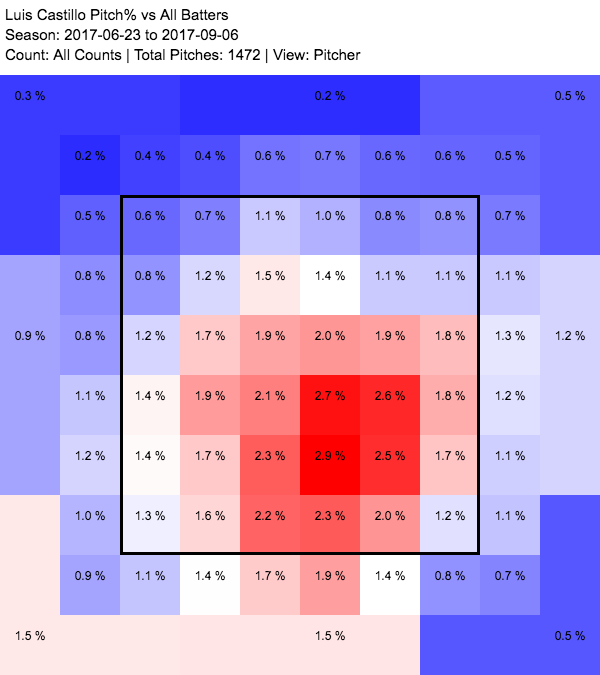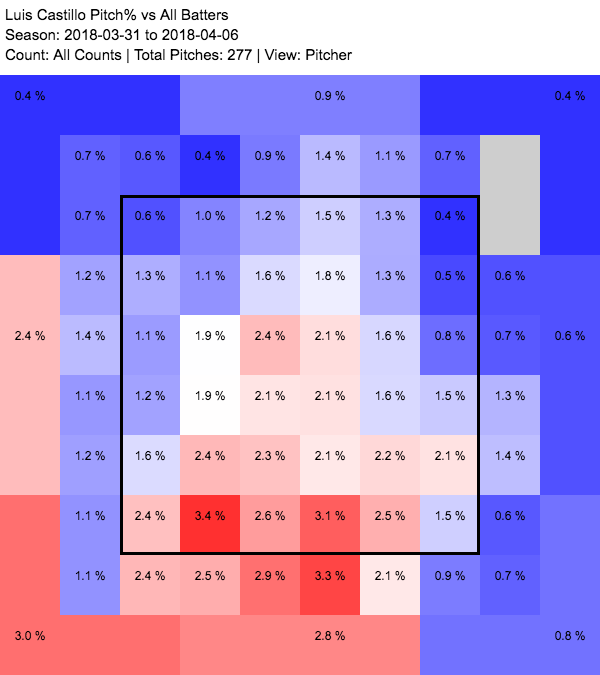(Photo by Shelley Lipton/Icon Sportswire)
Aside from Aaron Nola, arguably no pitcher is a greater poster boy for Pitcher List than flamethrowing Cincinnati Reds right-hander Luis Castillo. Thanks in part to the analysis driving The List, Castillo’s fantasy stock gained significant helium heading into the season, as Castillo was ranked inside the Top 20 on the initial rendition of this season’s List (and was even taken 62nd overall in the staff Future Leagues draft). After an impressive rookie season run with Cincinnati in 2017 (3.12 ERA, 1.07 WHIP, 98 K/89.1 IP, 9.87 K/9), Castillo was tabbed as this season’s next great sleeper, to the point where the hype began to erode his profit potential.
Yet after two lackluster starts to open the season, Castillo has some fantasy owners questioning whether they should have believed the hype. At this point in the season, it’s easy to write off Castillo’s 9.00 ERA and 1.60 WHIP with a dismissive “It’s early”. However, if you owned Castillo, you put a significant amount of trust in his ability to take a step forward, and you owe it to yourself to come along with me on a journey to see what lies behind Castillo’s first two starts.
Start #1: 3/31 vs. WSH: 5.0 IP, 6 H, 6 ER, 1 BB, 6 K, 13 swinging strikes
Start #2: 4/6 @ PIT: 5.0 IP, 6 H, 4 ER, 3 BB, 3 K, 19 swinging strikes
Batted Ball Profile for Castillo (2017 vs. 2018)
| GB | FB | LD | |
| 2017 | 130 | 64 | 27 |
| 2018 | 15 | 12 | 6 |
Batted Ball Profile for Castillo (% Distribution)
| GB/FB | LD% | GB% | FB% | HR/FB% | Pull% | Cent% | Oppo% | |
| 2017 | 2.03 | 12.2% | 58.8% | 29.0% | 17.2% | 40.7% | 30.5% | 28.8% |
| 2018 | 1.25 | 18.2% | 45.5% | 36.4% | 16.7% | 54.5% | 27.3% | 18.2% |
Contact Distribution
| Soft | Medium | Hard | |
| 2017 | 22.1% | 48.2% | 29.6% |
| 2018 | 24.2% | 36.4% | 39.4% |
In a small sample thus far, Castillo is allowing line drives with greater frequency (almost 50 percent more often) and his hard contact percentage has also spiked, from 29.6 to 39.4%. Castillo is also struggling to keep the ball on the ground as often as he did last season, as his GB/FB ratio has dropped from 2.03 to 1.25. Hitters are hitting the ball harder more often, hitting the ball in the air, and pulling the ball more frequently. When hitters are pulling the ball more frequently than ever and hitting the ball with greater authority, it doesn’t bode well, especially when you play half your games in hitter-friendly Great American Ball Park. You can’t even claim that Castillo has been unlucky on fly balls turning into home runs, as his HR/FB% is actually somehow lower than his mark from last year.
To compare what Castillo is doing with his pitches this season, let’s look at his heat maps. Here’s 2017:


Looking at the heat maps, Castillo’s pitch location has been considerably worse than last season. If you compare the far edges of the strike zones, Castillo’s pitches are missing low and outside twice as often as they were last season (3.0% compared to 1.5%). He’s missing on the far outer edge almost three times as often (2.4% vs. 0.9%), and 2.8% of his pitches are getting buried outside the zone, relative to 1.5% last season. This isn’t just a guy who’s missing his spots; it’s a guy who’s missing his spots badly. As you’d expect, Castillo’s ability to locate the ball within the zone has dropped off considerably, from 47.0% last year to 36.1% this season. To put it into perspective, Clayton Kershaw was at 49.5%, while Wade Miley had a mark of 35.0% last season.
Within the strike zone, however, we see some positive signs. Last season, Castillo had a problem with throwing pitches around the heart of the plate and the low-middle portions of the strike zone. In the 2017 heatmap, you can clearly see a quadrant where Luis Castillo was locating his pitches 10.7% of the time. Castillo also struggled to hit the edges of the strike zone just 26.9% of the time, compared to 31.6% of the time this season. When Castillo’s pitches do find the strike zone, he’s illustrated potential for keeping the ball away from dangerous and vulnerable locations.
To his credit, though, Castillo has actually experienced an uptick in swinging strike percentage, as he has 32 whiffs across his first 2 starts (good for a 16.2 swinging strike percentage, up from 12.6 last year). Hitters are making contact on 64.8% of swings, down from 73.1% last year, and Castillo’s ability to make hitters miss like that despite badly missing his spots is a credit to both the quality of his stuff and the latent potential he has for keeping the ball away from the nitro zones of the strike zone if and when his command improves. His fastball velocity remains elite at 95.8 mph, and all of the numbers point to a pitcher who is merely struggling with command, which can hardly be surprising for a young pitcher with less than 100 innings of MLB experience.
A look at his peripherals (45.5% LOB, .323 BABIP/18.2 LD%, 3.60 BB/9) provide reasons for encouragement. Despite the struggles in his command, it hasn’t yet meant an overly dramatic slide in his walk rate, as he posted a 3.22 BB/9 last season. Even in the context of an elevated LD% which could drop, his .323 BABIP is inflated and should also taper off, even if he fails to limit hard contact like he did last season. A 45.5% LOB is ridiculously low, especially for a pitcher with as much strikeout ability as Castillo. Even if Castillo doesn’t take the step forward that he’s capable of, he’s still showing the capability to be the highly valuable low-end SP2/high-end SP3 we thought he would be.
As far as what’s actually in his arsenal right now, Castillo’s pitch selection and pitch values provide some additional food for thought.
| Pitch Type | 2017 Percentage | 2018 Percentage | Pitch Values (2017/18, per 100 pitches) |
| Fastball | 62.4 | 57.8 | -0.10/-2.74 |
| Slider | 15.0 | 10.9 | 2.11/0.51 |
| Changeup | 22.7 | 31.3 | 3.01/-1.18 |
Although it’s his high-octane fastball that generates buzz, Castillo’s changeup was his most effective pitch last season and his second most frequently thrown pitch. The spike from 22.7% to 31.3% seems like a conscious shift to move off of relying too heavily on a fastball that actually didn’t generate above-average results last season and toward becoming a more complete pitcher who can capably utilize his secondary offerings. Initial data indicates that Castillo is experiencing an adjustment period and some command issues that stem from trying to utilize his secondary offerings more and work the edges of the strike zone more than just getting the ball over. A look at the Reds’ schedule reveals the following matchups ahead for Castillo:
4/11 @PHI
4/16 @MIL
4/22 @ STL
4/27 @ MIN
5/2 vs. MIL
5/7 vs. NYM
Final Verdict: Hold/Buy Castillo
Four consecutive road matchups bodes pretty well for Castillo, as last season, he had a 2.84 ERA in 8 road starts, compared to a 3.40 mark in 7 home matchups. Castillo struggled more with keeping the ball in the park at home (7 HR in 45 IP), which is in line with Great American Ball Park’s reputation as a launching pad, and even in the context of this season’s incredibly limited sample size, Castillo has given up both of his home runs in his solitary home start. Castillo is a pitcher who’s facing some growing pains as he refines his arsenal and his command, but even amidst his struggles, Castillo has shown an increased ability to make hitters miss and I’d expect his ridiculously low 45.5 LOB% to normalize starting today, which should give his fantasy owners some much-needed relief.

Posted this the other day after his last start, but might have been too late on the comment board. Hated the game Mesoraco called for Castillo and looked into more closely.
Through 11 starts w/ Barnhart, Castillo averages 6.2 IP, 3.04 ERA, 0.99 WHIP, 7.4 K, 1.7 BB
Through 5 starts w/ Mesoraco, Castillo averages 5.5 IP, 5.27 ERA, 1.50 WHIP, 4.2 K, 3.2 BB
This was on full display in both starts this season:
1st start w/ Tucker: 27.3% K-rate, 4.6% BB-rate, 21.2% SwStr, 68.2% F-strike, 2.72 SIERA, 2.92 xFIP.
2nd start w/ Mesoraco: 12.5% K-rate, 12.5% BB-rate, 12.2% SwStr, 50.0% F-strike, 5.41 SIERA, 5.31 xFIP.
I’m not saying he looks great and everything was rosy with Tucker behind the plate in that first start, but I feel this is certainly something worth keeping an eye on, if only for his confidence.
Mike, that’s some pretty compelling analysis. I wasn’t even thinking about how much of a difference the catcher behind the plate could make, but that’s definitely the case (as with Jon Lester’s renaissance season in David Ross’ final campaign). Even more reason to be optimistic about Castillo’s chances for finding sustained success as the season goes on.
Thanks, Ben. Now if only someone would tell Bryan Price about this as I see Mesoraco is getting the start tonight. Sigh.